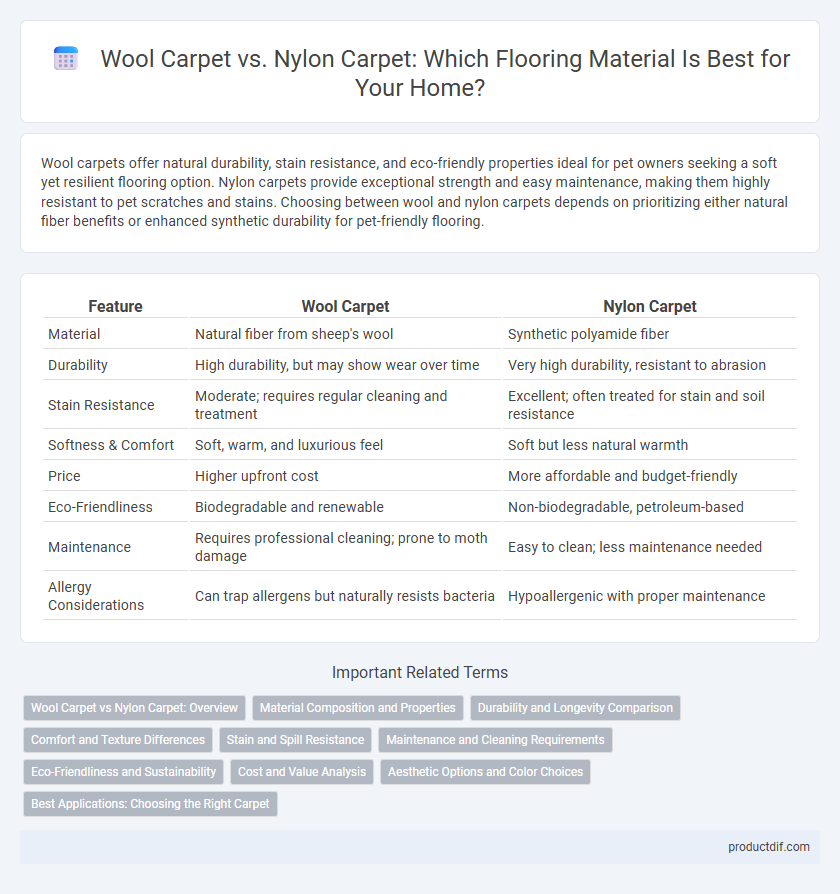Wool carpets offer natural durability, stain resistance, and eco-friendly properties ideal for pet owners seeking a soft yet resilient flooring option. Nylon carpets provide exceptional strength and easy maintenance, making them highly resistant to pet scratches and stains. Choosing between wool and nylon carpets depends on prioritizing either natural fiber benefits or enhanced synthetic durability for pet-friendly flooring.
Table of Comparison
| Feature | Wool Carpet | Nylon Carpet |
|---|---|---|
| Material | Natural fiber from sheep's wool | Synthetic polyamide fiber |
| Durability | High durability, but may show wear over time | Very high durability, resistant to abrasion |
| Stain Resistance | Moderate; requires regular cleaning and treatment | Excellent; often treated for stain and soil resistance |
| Softness & Comfort | Soft, warm, and luxurious feel | Soft but less natural warmth |
| Price | Higher upfront cost | More affordable and budget-friendly |
| Eco-Friendliness | Biodegradable and renewable | Non-biodegradable, petroleum-based |
| Maintenance | Requires professional cleaning; prone to moth damage | Easy to clean; less maintenance needed |
| Allergy Considerations | Can trap allergens but naturally resists bacteria | Hypoallergenic with proper maintenance |
Wool Carpet vs Nylon Carpet: Overview
Wool carpet offers natural durability, exceptional softness, and excellent insulation, making it a premium, eco-friendly flooring choice with inherent stain resistance and flame retardance. Nylon carpet provides superior resilience and abrasion resistance, ideal for high-traffic areas, with greater colorfastness and easier maintenance compared to wool. Both materials vary widely in cost, environmental impact, and performance characteristics, influencing choice based on specific needs and budget.
Material Composition and Properties
Wool carpets are made from natural fibers obtained from sheep, offering excellent insulation, durability, and resistance to dirt and flame, with a soft texture and natural warmth. Nylon carpets, composed of synthetic polyamide fibers, provide superior abrasion resistance, elasticity, and stain resistance, making them ideal for high-traffic areas with enhanced color retention. Both materials exhibit unique properties where wool excels in sustainability and comfort, while nylon surpasses in durability and maintenance ease.
Durability and Longevity Comparison
Wool carpets offer natural resilience and can last 15 to 20 years with proper care, resisting crushing and matting while maintaining appearance. Nylon carpets provide superior durability, often enduring heavy foot traffic for 10 to 15 years, with excellent resistance to abrasion, stains, and fading. While wool excels in natural fiber benefits and longevity, nylon's synthetic properties make it a cost-effective choice for high-traffic areas requiring robust wear resistance.
Comfort and Texture Differences
Wool carpets offer a naturally soft, luxurious texture that provides exceptional comfort and insulation, making them ideal for cozy living spaces. Nylon carpets are known for their durability and resilience, with a slightly firmer texture that resists crushing and matting over time. The plush feel of wool enhances warmth and softness underfoot, while nylon's synthetic fibers deliver a more uniform texture that withstands heavy foot traffic.
Stain and Spill Resistance
Wool carpets naturally resist dirt and stains due to their dense fiber structure and lanolin content, making them effective at repelling spills. Nylon carpets offer superior stain resistance when treated with advanced stain protection technologies, which enhance their durability against common household spills. Both materials require prompt cleaning to maintain appearance, but nylon's synthetic fibers typically provide easier maintenance and faster drying times compared to wool.
Maintenance and Cleaning Requirements
Wool carpets require specialized cleaning methods due to their natural fiber composition, including gentle vacuuming and periodic professional cleaning to prevent damage and maintain softness. Nylon carpets offer higher stain resistance and can withstand more aggressive cleaning techniques such as steam cleaning and stronger detergents, making maintenance easier for high-traffic areas. Both materials benefit from regular vacuuming, but nylon typically requires less frequent deep cleaning compared to wool fibers.
Eco-Friendliness and Sustainability
Wool carpets are highly eco-friendly due to their natural, biodegradable fibers and renewable sourcing from sheep, reducing environmental impact. Nylon carpets, while durable and often made with recycled content, typically rely on petrochemical processes that contribute to higher carbon footprints. Choosing wool supports sustainable practices and organic material use, whereas nylon's sustainability depends on recycling rates and manufacturing improvements.
Cost and Value Analysis
Wool carpets generally have a higher upfront cost compared to nylon carpets due to their natural fiber composition and durability. Nylon carpets offer a more budget-friendly option with decent resilience and stain resistance, making them cost-effective for high-traffic areas. When evaluating value, wool provides long-term benefits in softness, insulation, and sustainability, while nylon excels in affordability and ease of maintenance.
Aesthetic Options and Color Choices
Wool carpets offer rich, natural hues with subtle variations that enhance texture and warmth, while nylon carpets provide a broader spectrum of vibrant, consistent colors ideal for dynamic interior designs. Wool's organic fibers create a luxurious, matte finish that complements traditional and rustic aesthetics. Nylon's synthetic composition allows for stain-resistant technology and brighter, more uniform tones, catering to contemporary and high-traffic environments.
Best Applications: Choosing the Right Carpet
Wool carpets excel in luxury residential spaces and high-end commercial environments due to their natural resilience, softness, and excellent insulation properties. Nylon carpets are better suited for high-traffic areas such as offices, retail stores, and playrooms because of their superior durability, stain resistance, and ease of maintenance. Selecting between wool and nylon depends on balancing aesthetic preference with practical needs like foot traffic, allergy considerations, and long-term wear.
Wool Carpet vs Nylon Carpet Infographic

 productdif.com
productdif.com